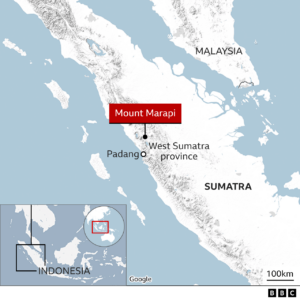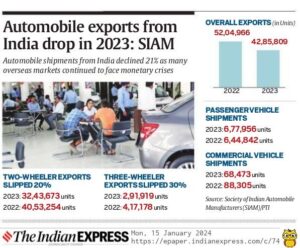Table of Contents
Kaleshwaram Lift Irrigation Project
Context: The Kaleshwaram Lift Irrigation Project (KLIP) in Telangana has been mired in controversy since its inception due to its extensive infrastructure including water tunnels, aqueducts, underground surge pools, and large pumps.
About Kaleshwaram Lift Irrigation Project (KLIP)
- Scale of the Project: The Kaleshwaram Lift Irrigation Project, situated on the Godavari River, ranks among the largest multi-purpose projects in the world.
- Project Objectives: It aims to supply water for irrigation and drinking purposes to approximately 45 lakh acres in 20 of Telangana’s 31 districts, encompassing major cities like Hyderabad and Secunderabad.
- Inauguration of the First Phase: The project’s first phase was officially inaugurated in June 2019.
We’re now on WhatsApp. Click to Join
Indonesia’s Mount Marapi
Context: Mount Marapi on the Indonesian island of Sumatra erupted again
About Mount Marapi
- Mount Marapi is situated near the centre of Java Island in Indonesia.
- The mountain stands at a height of 2,891 metres.
- Known as “Mountain of Fire,” Mount Marapi is one of Indonesia’s most active volcanoes.
- It is a popular destination for hiking enthusiasts.
- Indonesia, including Mount Marapi, is part of the Pacific Ring of Fire, a region with high volcanic and seismic activity due to tectonic plate movements.

|
Note |
| Pacific Ring of Fire, also known as the Circum-Pacific Belt, is a path along the Pacific Ocean characterised by active volcanoes and frequent earthquakes. |
Quantum Computing
Context: Quantum computing will revolutionise computing beyond the limits of traditional binary systems.
About Quantum Computing
- Quantum computing is a branch of computer science applying quantum theory principles.
- These computers are uniquely adept at navigating vast arrays of possibilities to identify viable solutions for intricate and challenging problems.
- Basic Unit of Information – Bit: A bit is the fundamental unit of data in computing, representing a binary digit. It’s the smallest piece of information a computer can store.
- Binary States of a Bit: In physical terms, a bit has two distinct states, often represented by high and low voltage levels. For instance, low voltage might correspond to the binary digit 0, while high voltage represents 1.
- Role of a Gate in Computing: A gate is a crucial circuit in a computer that modifies the state of bits in a predictable and controlled way.
- Binary Data Processing: These gates are instrumental in processing binary data (0s and 1s), which is the core of digital computing.
- Impact on Computer Speed: The operational speed of these gates is a key determinant of how quickly a computer can function, affecting its overall processing power.
- Semiconductor Transistors in Modern Computers: Modern computers use semiconductor transistors to create circuits functioning as bits, with semiconductor chips holding over 100 million transistors in just 1 square millimetre.
- Miniaturisation and Quantum Effects: As transistors get smaller, they become more susceptible to quantum effects, which can compromise the reliability of current technology, setting a limit to transistor density.
- Moore’s Law Limitations: Initially, Moore’s law (1965) predicted a tenfold increase in computing power every five years.
- However, this pace has slowed to a doubling every five years, signalling a potential shift towards quantum computing.
- Quantum Bits (Qubits): The fundamental unit of a quantum computer is a qubit, which, unlike a traditional bit, can exist in two states simultaneously.
- Examples include the spin of a particle or a superconducting circuit acting like an atom.
- Function of Quantum Gates: Quantum gates are physical processes or circuits that alter the state of one or more qubits, often using electromagnetic pulses in quantum computing contexts.
- Superposition in Quantum Physics: Unlike conventional bits, a qubit can be in a superposition of both its states simultaneously, similar to moving northeast, which combines movements north and east.
- Superposition in Quantum Computing: A qubit’s superposition allows quantum computers to perform calculations on multiple states at once, offering significant computational speed advantages over traditional computers.
Quantum Gates Operation In Computing
- Role: Quantum gates process information in quantum computers by acting on qubits.
- NOT Gate: This gate alters a qubit’s state from 0 to 1 or vice versa. Its effect on a superposition is to create another superposition, affecting each basis state.
- Common Feature of Quantum Gates: All quantum gates transform a superposition into another superposition, based on their effect on the individual basis states.
- Function of Hadamard Gate: The Hadamard gate operates on a single qubit to generate a superposition of its basis states.
- Controlled-NOT (CNOT) Gate: This gate involves two qubits – a control qubit and a target qubit. The state of the target qubit changes only if the control qubit is in state 1.
- The CNOT gate, along with other single-qubit gates, can perform all logical operations on binary data encoded in qubits, forming complex quantum circuits.
Leading the Climate Dance
Context: The article discusses the persistent problem of air pollution in India particularly in the National Capital Region (NCR) highlighting that it has become a perennial issue rather than a seasonal inconvenience.
Characters And Their Role
- Scientists & Academics: Diligently gathered evidence, painting a clear picture of the problem. But they’re not equipped to make the tough choices – societal values and trade-offs need to be factored in.
- Activists: Push for pro-green solutions. But their often rigid stance, advocating for only their way, can stifle open discussion and compromise.
- Courts: While not the ideal forum for solving the problem, they can play a crucial role in ensuring platforms for healthy debate and decision-making.
- Politicians: Despite some past successes, politicians mostly stumbled in addressing the crisis effectively. Mostly hesitant to make tough calls, often succumbing to the pressure of vocal middle-class opposition to inconvenient solutions.
Case Studies And Lesson Learned
- BRT corridor: This ambitious project aimed to improve public transport by prioritising dedicated bus lanes.
- However, it faced strong opposition from the car-dependent middle class, leading to its dismantling. This case study highlights the public’s reluctance to accept inconvenience for long-term environmental benefits.
- Odd-even experiment: This policy, restricting private vehicle use based on licence plate numbers, offered temporary relief during severe pollution episodes.
- However, its effectiveness is debatable and its reliance on short-term measures hinders long-term solutions.
- Crop-burning challenge: This agricultural practice contributes significantly to NCR’s air pollution.
- Requires a multi-pronged approach, including technological advancements, regulatory measures, financial incentives for farmers, and effective communication to change mindsets.
Moving Forward: A Collaborative Two-Step
- The Public’s Lead: Increased use of public transport and adoption of cleaner technology, can incentivize politicians to take bolder steps.
- Politicians’ Responsibility: Setting a clear political narrative, one that acknowledges the need for trade-offs and actively seeks public buy-in, is crucial for progress.
Towards A Pragmatic Future
Context: Despite rising emissions and dependence on fossil fuels India seeks to decarbonize by scaling up renewables, electrifying transport, and exploring green hydrogen. Challenges in policy, infrastructure, and technology require collaborative efforts for a clean future.
Challenges of Decarbonization in India
- Rising Emissions: India’s CO2 emissions projected to cross 3 Gt by 2023, 8% higher than 2022 and double China’s growth rate. However, per capita and cumulative emissions remain lower (1.9t/capita, 3% global share).
- Sectoral Breakdown: Energy sector dominates with 76% of GHG emissions, mainly from power generation (39% of CO2) followed by transport and iron/steel. Agriculture and industrial processes contribute 13% and 8% of GHGs, respectively.
- Fossil Fuel Dependence: Power generation and transport heavily rely on fossil fuels. While EVs hold promise, grid dependence for charging can negate benefits. Heavy transport and industries like iron/steel lack feasible fossil fuel replacements.
- Green Hydrogen Hype: Touted as a solution, green hydrogen production is currently negligible (less than 1% globally). Large-scale production requires vast amounts of green power and water (5MMT by 2030 needs 125 GW renewables, exceeding current solar/wind capacity). Transportation and storage pose additional challenges.
- Renewable Energy Bottlenecks: Scaling up renewable capacity is crucial, but India’s growth, despite being rich in resources like solar, is insufficient. Policy hurdles (custom duties, approved manufacturers list) and state-level issues (land acquisition, payments, grid access) impede rapid growth. Rooftop solar needs easier financing.
- Policy Inconsistencies: Flip-flops like announcing 80 GW new coal capacity after a coal-free future pledge create uncertainty and hamper decarbonization efforts.
Way Forward
Prioritise and expedite renewable energy expansion:
- Address policy bottlenecks: Remove custom duties on crucial components, re-evaluate the list of approved manufacturers to encourage competition, and streamline permitting processes.
- Empower states: Simplify land acquisition for renewable projects, ensure timely payments to generators, and improve grid access to facilitate integration.
- Promote rooftop solar: Offer easier financing options and incentives to encourage wider adoption.
- Focus on research and development: Invest in advanced renewable technologies like offshore wind and next-generation solar cells to enhance efficiency and bring down costs.
Embrace electric vehicles (EVs) but address limitations:
- Incentivize EV adoption: Provide subsidies, tax breaks, and build robust charging infrastructure, especially for two and three-wheelers.
- Develop renewable energy sources for grid: Expand renewable capacity to avoid dependence on fossil fuel-based grids for charging EVs.
- Explore alternative solutions for heavy transport: Research and develop hydrogen fuel cells, biofuels, and other non-battery options for trucks and other heavy vehicles.
Invest in green hydrogen but manage expectations:
- Set realistic targets: Focus on producing green hydrogen for niche applications initially, like fertilizer production and heavy transport, before aiming for large-scale deployment.
- Develop technologies for efficient production, storage, and transportation: Research advancements in electrolysis, storage materials, and pipeline infrastructure to overcome current challenges.
- Prioritise renewable energy and water conservation: Ensure green hydrogen production doesn’t compromise on other sustainability goals.
Maintain policy consistency and build public trust:
- Avoid flip-flops and ensure long-term commitment: Stick to announced plans like no new coal plants after 2027 to create a stable environment for investors and the public.
- Increase transparency and public engagement: Communicate progress, challenges, and future plans openly to build trust and encourage public participation.
- Invest in environmental education and awareness: Help citizens understand the urgency of decarbonization and their role in making it a reality.
Automobile exports from India
Context: Automobile exports from India declined by 21%.



 Dalai Lama Confirms He will have a Succe...
Dalai Lama Confirms He will have a Succe...
 Transforming Remittances Landscape in In...
Transforming Remittances Landscape in In...
 QUAD Countries: Members, Objectives, Imp...
QUAD Countries: Members, Objectives, Imp...





















